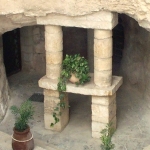
However, while Mary was still a child, her parents, Joachim (“yo‘-uh-kim”) and Anne, moved the family about four miles southeast to the village of Nazareth (“naaz‘-uh-reth”). Nazareth had a population of only 400 people, and so everyone there knew one another and knew one another’s business.
Mary grew up in Nazareth and, as a teenager (at about the age of 16), she was betrothed to a young man in the village named Joseph. Marriages were often arranged by parents in those days, and we don’t know whether Mary’s betrothal to Joseph was arranged. However, First Century betrothals were much more formal and more legally binding than the casual “engagements” we have today that can be easily broken.
In other words, the villagers of Nazareth considered Mary and Joseph to be legally married – except that Mary and Joseph were in the one-year waiting period before the actual ceremony, and except that during this waiting period, Mary continued to live with her parents.
And it was during this one-year waiting period, while Mary was still living with her parents, that the angel, Gabriel, appeared to her one day (local history says she was drawing water at Nazareth’s community well at the time). Gabriel told Mary that she was going to be supernaturally impregnated by the Holy Spirit, and that she was going to be the mother of Jesus – the Christ, the Messiah, the Savior, the Son of God.
Soon, Joseph learned that Mary was indeed pregnant, and he decided to quietly divorce her. (He could have had her stoned to death, but he seems to have truly loved her.)
Then an angel also appeared to Joseph, and the angel explained that Mary was going to be the mother of the Messiah, and that Joseph need to continue with their marriage. So Joseph ended their waiting period, had a quiet marriage ceremony, and took Mary home with him as his legal and proper wife.
A few months later, Joseph and Mary were required to travel to the village of Bethlehem (“beth‘-leh-him”) to be counted in a Roman census that was being taken that year. And while they were there, Jesus was born in a local animal’s cave (animals commonly slept in caves in that region), and was put to bed in an animal’s feed trough (a “manger”). Today we call these events “The Christmas Story.”
After living for a time in Bethlehem, and after a period of exile in Egypt to hide from the king of Israel’s soldiers (the king wanted to kill Jesus), Joseph and Mary finally returned home to Nazareth and lived out their lives there, with Joseph operating a woodworking and builder’s business, and Mary helping in the business and working as a busy mother.
Following Jesus’s birth, Joseph and Mary had a large family over the years, including five boys named James, Joseph, Simon, Jude and, later in life, a son named Amos. They also had three girls, thought to have been named Miriam, Martha, and Ruth.
Two of Jesus’s half brothers, James and Jude, wrote letters that are in today’s New Testament part of the Bible; and the “bone box” (a stone coffin that held a person’s bones) of Jesus’s half brother, James, has been found and identified in Jerusalem.
Jesus’s adoptive father (that is, His stepfather), Joseph, is thought to have died in midlife. But Mary lived a long and full life and, according to local history, she is buried in a cave on the Mt. of Olives near Jerusalem.
Here are photos of some of the places that Mary lived and worked, with captions. Click the photos to enlarge them and see the captions.
[envira-gallery id=”4384″]
All Domestic and International Rights Reserved.
